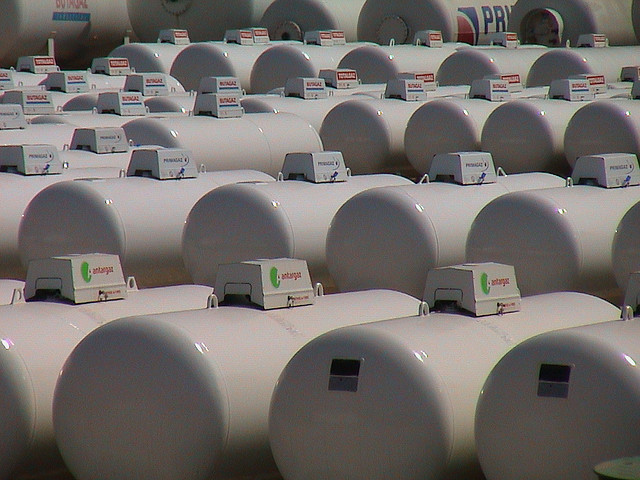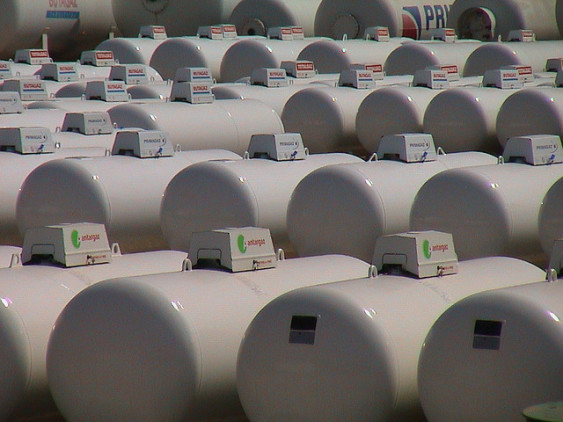The latest wave in the tsunami of the Northwest fossil fuel export schemes has washed up in the form of a propane-by-rail facility on the Columbia River. A firm currently calling itself Waterside Energy recently announced plans for a $450 million liquefied petroleum gas (LPG), or propane, export project at the Port of Longview in Washington. The proposal comes on top of a revamped plan by the company to develop an $800 million oil refining operation there to be called Riverside Refinery.
The proposal
At full capacity, the propane export and storage facility, called “Washington Energy Storage and Transfer,” would serve one train each day with 75,000 barrels of propane delivered from Canada and North Dakota. The fuel would then be pumped from rail tank cars into the terminal’s storage tanks, which could store up to 1.1 million barrels. (The site would include five spherical tanks capable of holding 23,000 barrels each, one 550,000-barrel tank, and two 222,000-barrel refrigerated tanks.) Four times a month, on average, the fuel would be piped from the refrigerated tanks onto a ship for export to Asia.
The project would be built on 75 acres of private land, but the Port has jurisdiction over the underground pipeline, rail corridor, and wharf needed for development and operations. The terminal would also require permits through Washington’s Energy Facility Site Evaluation Council (EFSEC).
The project backers
Curiously for a billion-dollar enterprise, Waterside Energy does not appear to have a website. Nor has the company published materials that describe the proposed Riverside Refinery or the propane facility. To date, the best sources of information about these projects are media accounts and a handful of documents provided by the Port of Longview. Waterside acknowledges that they are represented by Strategies 360 (as Sightline reported in June), a politically well-connected consulting firm that advocates for numerous Northwest coal and oil projects.
Waterside Energy is the latest name of a peculiar venture with a shadowy existence at best. Although it’s often cited as a Texas-based company, neither Texas nor Washington has record of an active corporation for the company’s current or previous titles. The firm’s prior name, Riverside Energy, appeared in Delaware incorporation records just before proposed oil agreements with the Port of Longview in 2014. The individual people backing the project have a troubled history in Washington: they are linked to unpaid debts and providing false information. What’s more, the LPG facility would be a joint venture with a partner that they have not yet announced.
The context
Nationally, the propane export industry is growing fast. US exports of propane and propylene (similar to and tracked in concert with propane by the US Energy Information Administration) stood at 600,000 barrels per day at last count in July 2015—up from less than 100,000 in July 2010. Although large-scale propane train movements are relatively new, one expert estimated there around 14,000 propane tank cars already operating across the US, and existing infrastructure to move propane is stretched by demand.
Given that growth, it’s not surprising that the Northwest has recently seen two similar proposals nearby. A 37,500 barrel per day propane project backed by the Pembina Pipeline Corporation at the Port of Portland was effectively killed by Mayor Charlie Hales’ refusal in May to let the permit process proceed. And in March 2015, the Port of Longview rejected a 47,000 barrel per day propane export terminal proposed by Haven Energy. Waterside’s proposal is around 60 percent larger than Haven’s plan at Longview and twice as big as Pembina’s first-phase proposal in Portland.
The risks
Propane handling comes with some notable risks. They include torch fires (gas and liquefied gas releases), flash fires (liquefied gas releases), pool fires (liquefied gas releases), and vapor cloud explosions (gas and liquefied gas releases). Propane also has a propensity for something called boiling liquid expanding vapor explosions (BLEVEs) when it is stored and/or transported in rail tankers, tanker trucks, bullet tanks, and other above-ground pressurized storage tanks. If large refrigerated tanks are breached, a heavy vapor cloud can escape and spread at the mercy of the wind. “Pools of fire” caused by propane explosions can burn hot enough to cause second-degree burns a mile away.
“Pools of fire” caused by propane explosions can burn hot enough to cause second-degree burns a mile away.
Accident data show that the largest propane risk areas are in pressurized storage, pressurized transport, and transfer. Propane trains bound for Longview would be at some meaningful risk of derailment along their journey, which would transit major Northwest cities like Spokane and Vancouver, Washington. At the facility itself, the moving propane tanker cars might be involved in a mishap. And transferring liquid propane—from rail cars to refrigeration units, to storage tanks, and to marine vessels—creates possibilities at each point of transfer for accidents or failures of pipes, valves, hoses, and other equipment.
Even a small flaw can compound quickly. In 1984, San Juanico, Mexico, was the site of one of the worst industrial accidents in history after a propane leak caught fire. The resulting explosion killed 500 people and severely burned more than 5,000. It flattened parts of town. The incident likely originated with a pipe leak due to excess pressure, and it magnified with the risks of a domino effect, in which one explosion leads to the next.
Potentially explosive energy plants pose terrorism risks, too, and facilities like the one proposed at Longview require significant security. Transporting propane to and from the facility is even more difficult to protect. At the Boston Distrigas LNG receiving facility, for example, the threat of propane ships to the City of Boston is so great that undercover agents roam the docks and dive teams inspect the wharf before each landing. The multi-layered perimeter of police that surrounds the ships includes ramming boats and heavy artillery, plus helicopters overhead. In fact, moving a propane ship through the harbor is consider risky enough that officials shut down largest bridge in New England during the passage. It’s a good preview of what might be in store for the Lower Columbia River when Longview-originated propane ships are moving out to sea.
The risk is not just theoretical. Propane storage facilities have targeted by terrorists before. In December 1999, the FBI foiled a plan by two militiamen who conspired to blow up a pair of 12-million-gallon refrigerated propane facilities in Elk Grove, near Sacramento, California. To prevent attacks, law enforcement creates ‘security zones’ of up to 500 yards around the ships carrying propane, interfering with both commercial and recreational river traffic.
Unfortunately, it is virtually impossible to secure the sprawling railway network that the Longview-bound propane trains would use. The rails traverse remote and rugged country, as well as hundreds of urban areas and small towns.
What comes next
Waterside anticipates starting the application process in 2015, submitting the application for site certification in January 2016—this stage would also trigger public comment and a land use hearing—and publishing a Draft Environmental Impact Statement in May 2016. The firm hopes for a final impact statement by January 2017, with the Governor making the final decision a couple months later, in March 2017.
In the meantime, Sightline will continue to monitor the project review process and will explore several dimensions of the plan, including its climate impacts.












Nabil ali
I need used tank or tanker lpg gas for sale you have